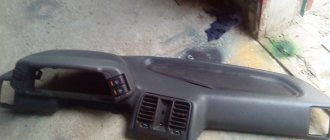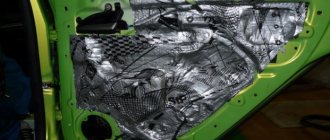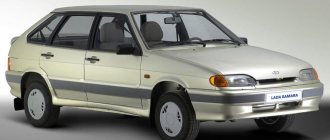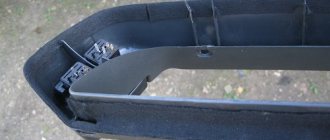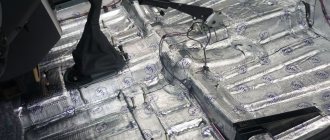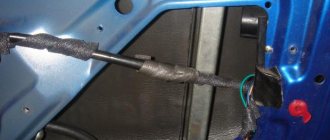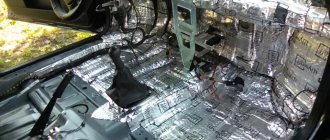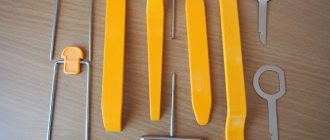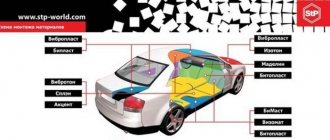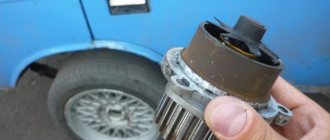Print this article Font size 16
The standard sound insulation provided for the VAZ 2110 leaves much to be desired. No, it cannot be called terrible, but there is always something to strive for.
If you don’t like the level of silence inside the cabin of your own ten, then you can easily solve this problem on your own by carrying out sound insulation.
Preparing for Shumka
Main difficulties
If you have already disassembled the interior of the car, you may have noticed that in the VAZ 2110 this is done quite simply. Even if you are new to this business, relying on the instruction manual, the work will be completed quickly enough. Additionally, we advise you to rely on video lessons. They can highlight a lot of useful and important things.
The main difficulty when disassembling the interior, without which it will not be possible to carry out full sound insulation, is dismantling the dashboard.
When disassembling the dashboard, be sure to mark all the parts, otherwise reassembling will turn into a real challenge.
The same instruction manual contains recommendations regarding dismantling the dashboard, so rely on it. Under no circumstances should you pull out all the cords, otherwise you will have problems later.
Soundproofing result
Soundproofing doors undoubtedly has a noticeable positive effect; it not only reduces road noise, but also improves the sound quality of music:
- However, it is worth recalling that without comprehensive sound insulation, you may not notice the effect of the doors!
- Many owners after this procedure claim that they do not see any difference!
- I would like to tell people - don’t suffer from bullshit, do complete sound insulation of the body for a noticeable effect
- We recommend modifying the door seals along with the doors; the sound insulation effect will double in this case!
Material consumption
If you do the insulation as prescribed in the instructions, you get:
- The front door needed vibroplast - 1.75 sheets
- Madeline - 0.5 sheets were needed to block all technological holes
- Vibroplast for the rear door - 1.25 sheets.
- Trunk door total - 0.5 sheet of vibroplast in total
- Sheet dimensions: 0.5 meters by 0.75 meters
- Sheet weight is approximately 1.2 kilograms
- The emphasis took about 0.8 square meters per door
- The calculation is given for ECO-2 materials
Materials
So, you have disassembled the interior, so you can start gluing the surfaces.
Don’t rush to spend a lot of money buying all the materials that catch your eye. Especially in stores they like to “cook” something more expensive, despite the fact that there are a lot of cheaper analogues. You can listen to our advice, and this will allow you to save a lot from a financial point of view, but provide the car with high-quality sound insulation.
| Material | Peculiarities |
| Vibroplast | You will be laying this material over areas of bare metal. Vibroplast looks like a mixture of rubber and foil. It is highly efficient and accessible. To work you will need 6 sheets measuring 400 by 900 millimeters |
| Izolon | Choose fine-bubble material 5 millimeters thick and 1000 millimeters long. Moreover, it is better to buy isolon in construction markets rather than in car dealerships, since it costs much less there. |
| Foam rubber | This is not a superfluous material at all in the process of sound insulation, which can be turned into a full-fledged bitoplast with your own hands. Choose foam rubber with a thickness of 1 centimeter |
The amount of material you will buy directly depends on the goals and objectives you have set. If this is complete sound insulation for almost the entire car, then take 5-6 sheets of each material. If the noise is partial, then focus on the size of the areas of the car that need to be treated with sound insulators.
Is there an effect
What does soundproofing a motor shield provide?
:
- Reduces engine noise.
- Reduces the level of vibrations on the body.
- Makes the engine shield stronger (the effect is similar to installing a bulkhead amplifier): less vibration on the steering wheel when driving, the steering wheel rotates more easily (on cars without ESD/power steering).
To reduce the noise level in the cabin by 2-4 dB (a difference of 1 dB is barely noticeable or not noticeable by ear at all), it is necessary to approach the sound insulation of the car comprehensively, work on all parts of the body (floor, doors, roof, trunk, dashboard, etc.). etc.), wheel arches and fender liners. Also, on LADA cars it would be a good idea to install additional door seals (instructions for XRAY, Vesta, Granta/Kalina/Priora, Largus and Lada 4x4).
Where to glue
Before you start work, be sure to familiarize yourself with the purpose of this or that material that will be involved in the soundproofing procedure of your car.
- Vibroplast will serve to cover exposed metal. The main function of a vibroplast is vibration damping.
- Izolon also has properties to dampen vibrations, but it is less effective compared to vibroplast. The structure of the material with closed cells will serve excellently as a second layer after vibroplast.
- Foam rubber is another layer that can be glued after vibroplast and isolon. The last layer will effectively absorb noise.
Dashboard noise
There was foam rubber, now there is bitoplast
It is quite possible to make bitoplast from foam rubber with your own hands. There is nothing complicated in this procedure.
You will need:
- Protective gloves;
- White Spirit;
- Rubber bitumen mastic.
So, let's get to work.
- Dilute the mastic with white spirit to obtain the consistency of liquid sour cream.
- Carefully treat the foam rubber with the resulting mixture.
- Let the material dry for some time.
- Use homemade bitoplast to soundproof your car.
The material should be dried in the open air, away from people. This is due to the fact that dangerous fumes are released during the drying process.
Second layer
In the same way, soundproofing material (Accent or Splen) is glued on top of the vibration insulation with glue, but here it is advisable to cover the entire area.
Preparatory activities
Having disassembled the interior and purchased the required amount of materials, you can begin the initial stages of sound insulation.
- Carefully remove all dirt, dust, debris from the places where you plan to paste the sound insulation;
- In addition to the interior, you can install additional Shumka on the hood and trunk. To do this, the casing is removed and access to the metal is gained;
- Cleaned surfaces are treated with degreasers. White spirit is quite suitable. After processing, dry everything dry.
When working with substances such as white spirit, be sure to use a protective mask or respirator. Inhaling fumes can cause serious poisoning and more.
Pasting
- Work begins with gluing vibroplast. In order for the material to lie down and stick to the surface better, it should be heated. A hair dryer is best.
- After heating a sheet cut to the shape of a section of metal, apply it to the surface.
- Pay special attention to the front panel, behind which the engine is located. This is the source of the most noise. Therefore, start pasting from there.
- Also carefully treat the front and rear doors with vibroplast, removing the trim from them, and the area where the muffler passes.
- Now let's move on to isolon. Depending on what you are going to soundproof, you may need about 6 sheets. After all, you can treat with Shumka not only the bottom of the cabin, trunk, hood and doors, but also the niche for the spare wheel, wheel arches, trunk floor, and roof.
- Areas such as the roof, arches, doors, and trunk are covered with isolon without the obligatory use of vibroplast. Although if you are doing work for yourself and for the long term, a vibroplast will not hurt.
- In areas where isolon is glued to open areas of metal, and not on top of vibroplast, use polyurethane foam. It securely holds the material, plus provides additional noise-absorbing properties.
- If you are soundproofing doors, then first there is a layer of vibroplast, and then isolon. You can't do without a double layer here.
- When disassembling the doors, you will see holes in the ends of the door. They are the sources of dust and dirt that penetrates under the casing. Therefore, we recommend treating them with noise and closing them.
- Izolon should be cut to the shape of sections of the door and other surfaces. The material is glued on top of the vibroplast using masking tape.
- For the casing pistons, you will need to make slits in the insulator. Make sure the pins go all the way in, otherwise the insulation will hang loose.
Trunk insulation
Let's get started
Soundproofing car doors first requires removing the door trim (the operation will be almost identical for all doors in the car), we dismantle the trim for the right front door, to remove the panel you need:
- Using a screwdriver, press the lock on the window lifter handle, photo below, and remove the handle
After releasing the lock, remove the handle
- Then pry up and remove the decorative panel from the armrest that covers the screws, unscrew the screws and remove the armrest
We pry up and remove the decorative panel covering the armrest mounting screws
- Then remove the bottom shelf for things; it is additionally held in place by several plastic clips, so you need to act carefully
Carefully remove the shelf for things
- After this, unscrew and remove the door lock button
- Then carefully remove the trim; it is attached to the door frame using eight plastic clips
- The process rarely goes without breaking the caps; it is better to purchase spare ones in advance
- The “native” (factory) sound insulation, if any, should be removed
- Now you can install soundproofing materials, having previously lubricated the surfaces with a degreaser (alcohol or acetone are also suitable), with the exception of the lower part of the door, where an anti-corrosion coating has been applied
All door sound insulation consists of several successive layers.
First layer
The first layer is to take Vibroplast or Shumoff material and glue it onto the inner surface of the outer side of the car door; you need to cut it into pieces in advance for greater convenience. The pieces are inserted through technological holes made in the inner lining of the door, having previously warmed the material with a hairdryer for better adhesion. Here, the larger the sheathing area we cover, the better the insulation. To avoid the appearance of air bubbles, roll out the material with a roller or the handle of a screwdriver.
Second layer
In a similar way, Accent soundproofing material is glued on top of the applied vibration insulation, but now it is desirable to cover the entire area with Accent.
Glue the internal surfaces with Accent and move on to the third layer
Third layer
The third layer completely covers all technological holes on the inside of the door with insulation. In this case, Madeline is used, under it we “hide” the contact points of all parts (such as wires, speaker mounts and places where the trim is attached to the doors)
Fourth layer
Car enthusiasts install additional sound insulator Bitoplast, which goes to the inside of the door trim. The soundproofing of the car doors is complete, we install the trim in the reverse order.
Advice: We recommend not using the car for two days, you need to give the insulation time to stick well.
Now your car has turned into a “corner of silence” in which the audio recorder sounds great.
Interior and trunk wrapping
Now you need to soundproof the car floor. For this purpose, vibroplast and splen are used. Vibroplast is laid as the first layer; it must be applied to the maximum area. Cover the material as best as possible so that it adheres to the metal surface. Splen is applied as the second layer. It also needs to be glued to the maximum area of the bottom of the cabin.
Recently, this type of sound insulation has become popular, such as applying a rubber-bitumen mixture to the outside of the car’s bottom. This allows you to reduce the level of vibration coming from the wheels and road surface. But it will be much more effective if you simultaneously treat the inner surface of the bottom. Everything inside the trunk needs to be carefully sealed with vibroplast. It will be a little more difficult here, since there is a niche for the spare wheel, protrusions for the shock absorber struts, and sometimes the edges of the screws come out.
FakeHeader
Comments 22
I looked at the blog from the smartest commentators and it’s either simply written modestly or there’s nothing at all! but everyone knows!
